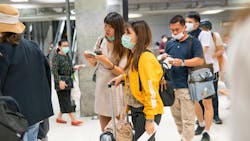The security industry’s role in containing the coronavirus
With more than 75,000 confirmed cases and 2,100-plus deaths, the recently discovered coronavirus (Novel Coronavirus or COVID 19) has sent public health officials globally scrambling to find ways to contain what’s become a pandemic. While the virus is centered primarily in China, cases have been reported around the world.
Although influenza viruses have killed more people this fall/winter season, it’s the fatality rate of the coronavirus that so frightens people. About 10 to 20 people per 100,000 infections die from the flu –– the coronavirus kills with more than 20 times that frequency.
According to the U.S. Centers for Disease Control and Prevention, coronavirus is typically spread by respiratory droplets from an infected person that land in the mouths or noses or inhaled into the lungs of people nearby. Epidemiologists can’t rule out the possibility that the disease can be spread by touching a surface or object that has the virus on it before touching their own mouth, nose or eyes.
That’s where those of us in the security industry can play a role. Think of the thousands of people who place their fingers or entire hands on biometric readers in order to authenticate their identities at immigration checkpoints. These devices that heighten security and add convenience to travelers may be helping to transmit the virus.
Then think of all the many other places contact biometric readers are used. You’ll see them as part of a two-factor authentication process inside and out of mission-critical public and private organizations. They are found worldwide as part of national ID and voter registration programs. And biometric readers are growing in popularity as a time and attendance solution.
Whether the concern is about passing the coronavirus, flu, or a host of other communicable diseases, we need to consider technologies that use contactless enrollment and authentication processes. Of the most widely used biometric technologies, only facial and iris recognition solutions are totally non-contact solutions.
However, take a look at passengers in any major international airport and you’re likely to see scores of people wearing masks, possibly goggles and other protective face and headgear. These wearables can easily defeat any facial recognition system. Even if passengers are willing to temporarily remove and replace facial coverings, the speed and convenience of the system is compromised.
That leaves other contactless biometric choices, including iris, voice, gait and odor. Among these choices, iris recognition is by far the most frequently deployed. It is also recognized for its speed and accuracy. One growing market for iris-based systems is the healthcare industry. Doctors and nurses are using portable readers to accurately identify patients before beginning treatments or administering drugs. Obviously, these people know a thing or two about passing disease.
While the public’s concern about the coronavirus is very high now, it’s important to remember the cost to U.S. businesses as a result of employee illness is measured in the hundreds of billions of dollars annually. Even a change to contactless biometric readers may make a positive difference.
Realistically, will hundreds or thousands of people contract the coronavirus through a contact-based biometric system? Probably not, but would you ask yourself or a loved one to use such a system today?
Mohammed Murad is vice president, global sales and business development, Iris ID
About the Author

Mohammed Murad
Vice President, Global Development and Sales, Iris ID
Mohammed Murad is VP of global sales and business development for Iris ID. Request more info about the company at www.securityinfowatch.com/10406656.
